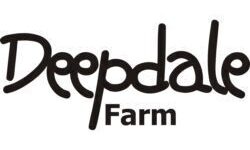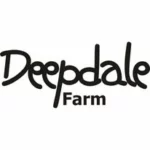Invertebrate survey 2022
Discover the rare species found on Deepdale Farm during our 2022 invertebrate survey. Find out about the methodology and if you want the exact detail, download the full report. Scroll down to watch the video and see Andy in action.

Invertebrate survey highlights
In 2022 Deepdale Farm gained funding from FIPL (Farming in Protected Landscapes) to complete an invertebrate survey. The timing of this, in year two of our conversion to organic status, and two years into our five-year mid-tier countryside stewardship scheme, was hoped to give a baseline study. The aim is to repeat it in 2025.
Andy Musgrove carried out the invertebrate survey, and here we share an overview of his methodology and the highlights of his findings. You can download the full report for further detail (see bottom of page). Andy hopes that this methodology can be repeated on other farms locally or across the country. Please do get in touch if you would like to learn more.
We were delighted by Andy’s findings, with 36 recorded species holding a conservation status. Every compartment of the farm surveyed showed a proportion of rarer species. It is worth noting that 2022 was the hottest summer on record, with just 274mm of rain across the six month survey, with 160mm of this falling in late August and September.
Method
The project funding allowed for six days of fieldwork, one per month between April and September 2022. Each day was divided into eight blocks, focusing on pre-defined compartments of the farm. The same compartments were used each month, although varying the order in which they were covered between months.
A 30-minute intensive survey using a variety of approaches was carried out in each block each month. Depending on the weather conditions these included suction-sampling, sweep netting, aerial netting, beating and larger species were just noted.
The compartments covered a variety of habitats including trees lining a field, cultivated margins, hedges, grass and wildflower mixes, clover leys, beetle banks, scrub and a small poplar plantation.
If you would like to review the methodology of the invertebrate survey and results in detail, then download the full report below.
Summary of records
A total of 668 species were recorded during the 48 timed surveys (eight compartments, six months). During the timed surveys, a total of 36 species (5.4%) were recorded that have a measure of conservation status.
Species diversity typically rises to mid-summer and then falls again, so the final rise in species in September was noteworthy, and almost certainly related to the effect of the drought in suppressing invertebrates in summer, followed by a quick response when rain fell in September.
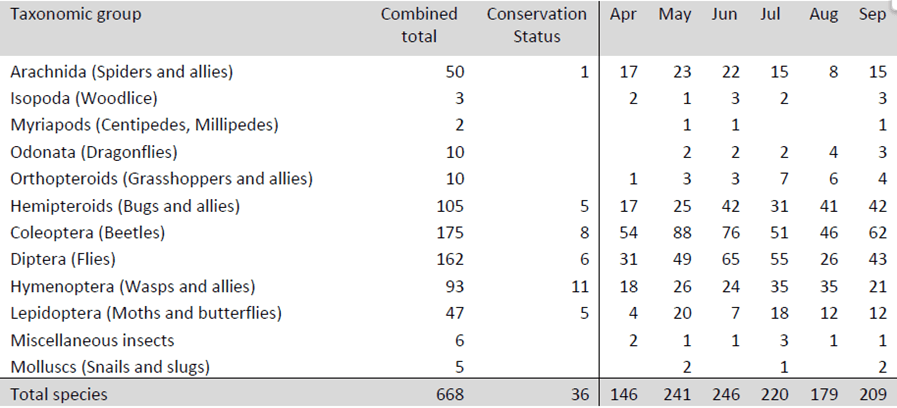
The Species Quality Index (SQI) was calculated using Pantheon; this is effectively a measure of the proportion of rarer species at a location (where 100 would represent no rarer species). The combined results sat at 125. But each individual compartment was also over 100, ranging from 106 to 134.
Invertebrate species with measures of conservation status
Here is a selection of the 36 species with conservation status which were recorded during the timed surveys. Please download the full report for further details.
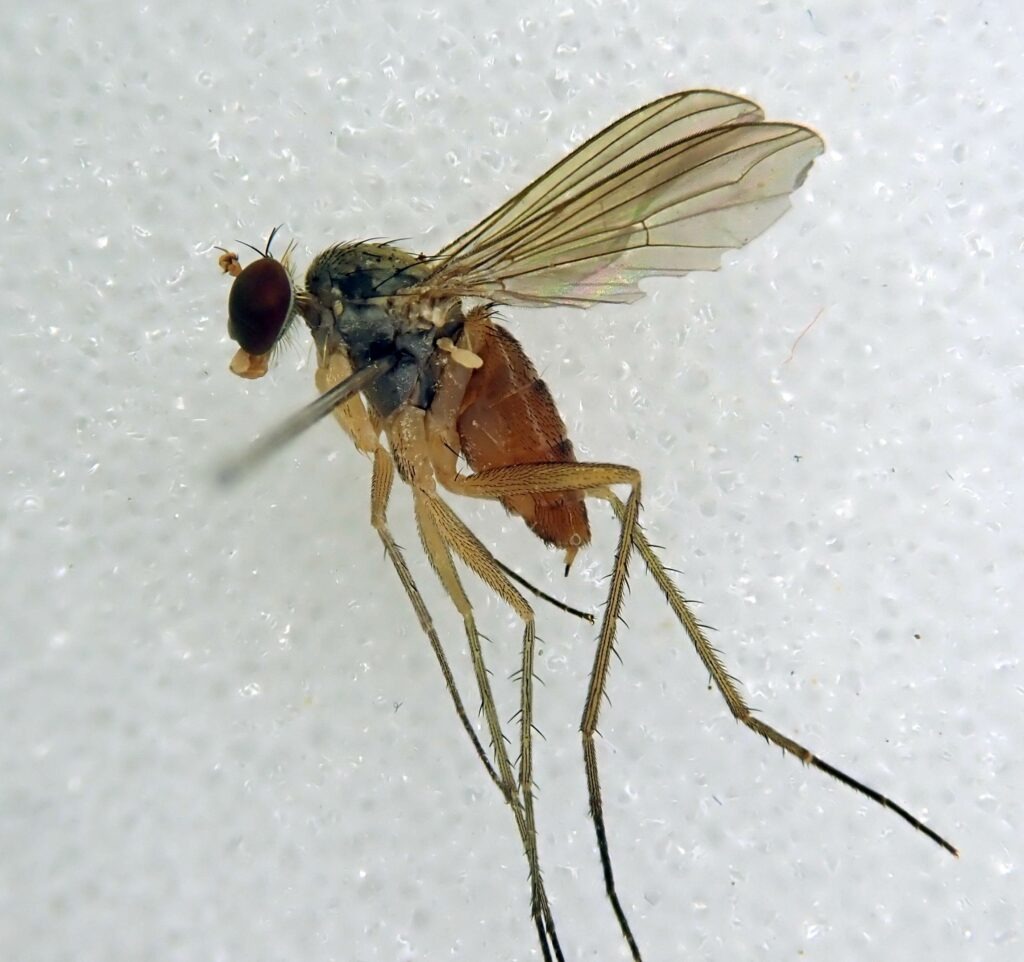
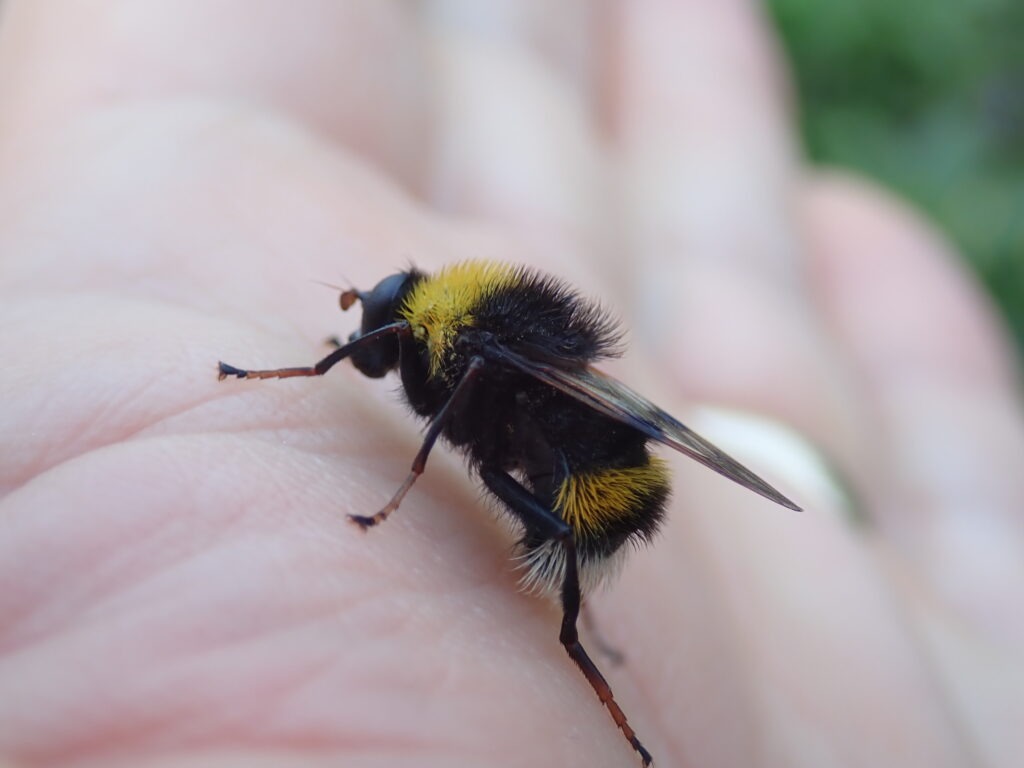
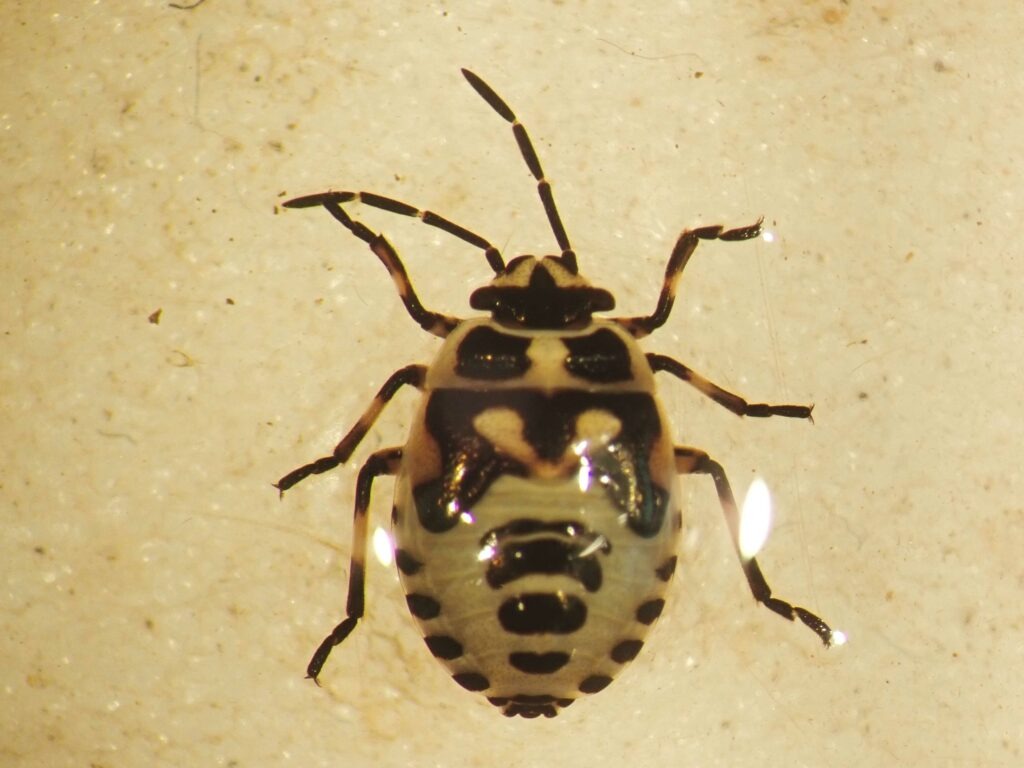
Neurigona abdominalis
A dolichopodid fly, swept at the pines. This would appear to be a very rare species and was assessed as Endangered and Nationally Rare by Drake (2018), who states this fly has only previously been found at four other locations in Britain, all in East Anglia. This is potentially one of the most significant finds of the 2022 Deepdale invertebrate surveys, therefore.
Pocota personata
A large and striking hoverfly that is a superb mimic of bumblebees. It is rather rare and localised, requiring old dead or decaying trees. One was found by the old beeches. This species has never before been recorded in Norfolk (or Suffolk) and was an excellent pointer to the importance of this stand of old trees. Status is currently Nationally Scarce.
Eurydema ornata (Ornate Shieldbug)
A strikingly-patterned shieldbug and a recent colonist from the continent, with scattered records across much of south-east England. An immature individual was one of the surprise finds of the survey. This was only the second time this species had been recorded in Norfolk (although it is expected to spread in coming years). Its status was assessed as Nationally Rare by Bantock (2016), meaning it was thought to occur in 15 or fewer 10-km squares in Britain.
Cistogaster globosa
A small but fairly distinctive parasitic fly, known to target the Bishop’s Mitre shieldbug Aelia acuminata, which itself occurs widely at Deepdale. The fly was discovered along the beetle bank, doubtless hunting out the shieldbugs. This fly was previously rather rare in the south-east but seemingly expanding its range north and west in open flowery habitats. The status of this group of flies has not been reassessed for some time; it was assessed as Endangered by Falk (1991) but that seems far too severe now, given its spread, and Nationally Scarce feels more likely to be appropriate.
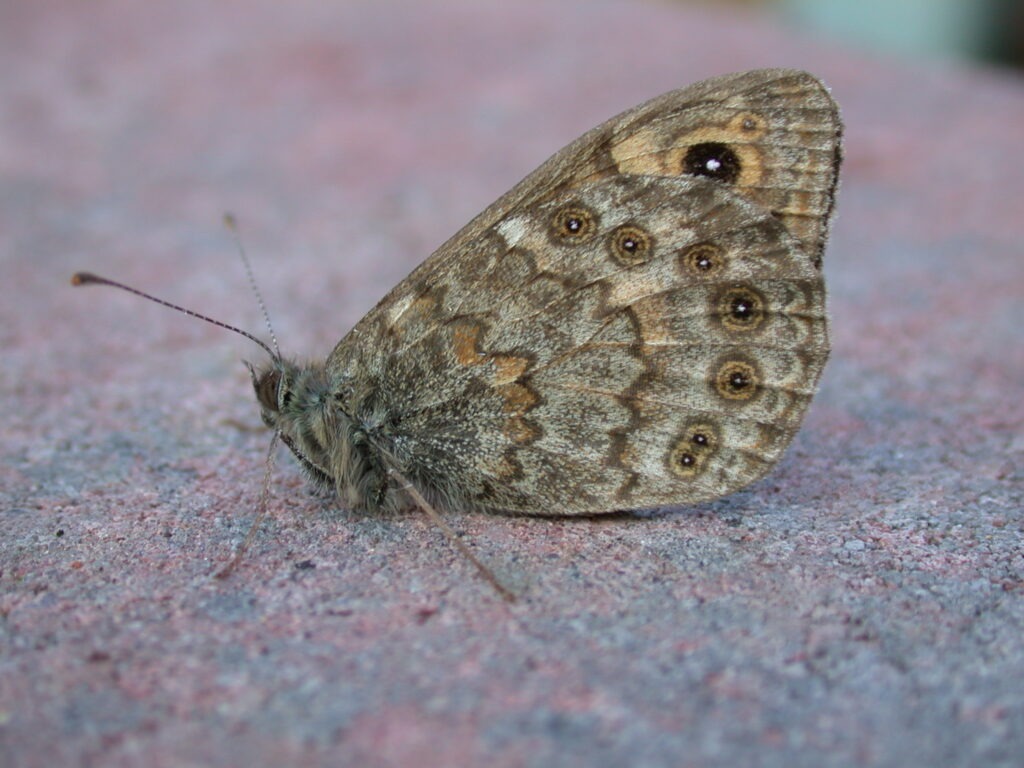
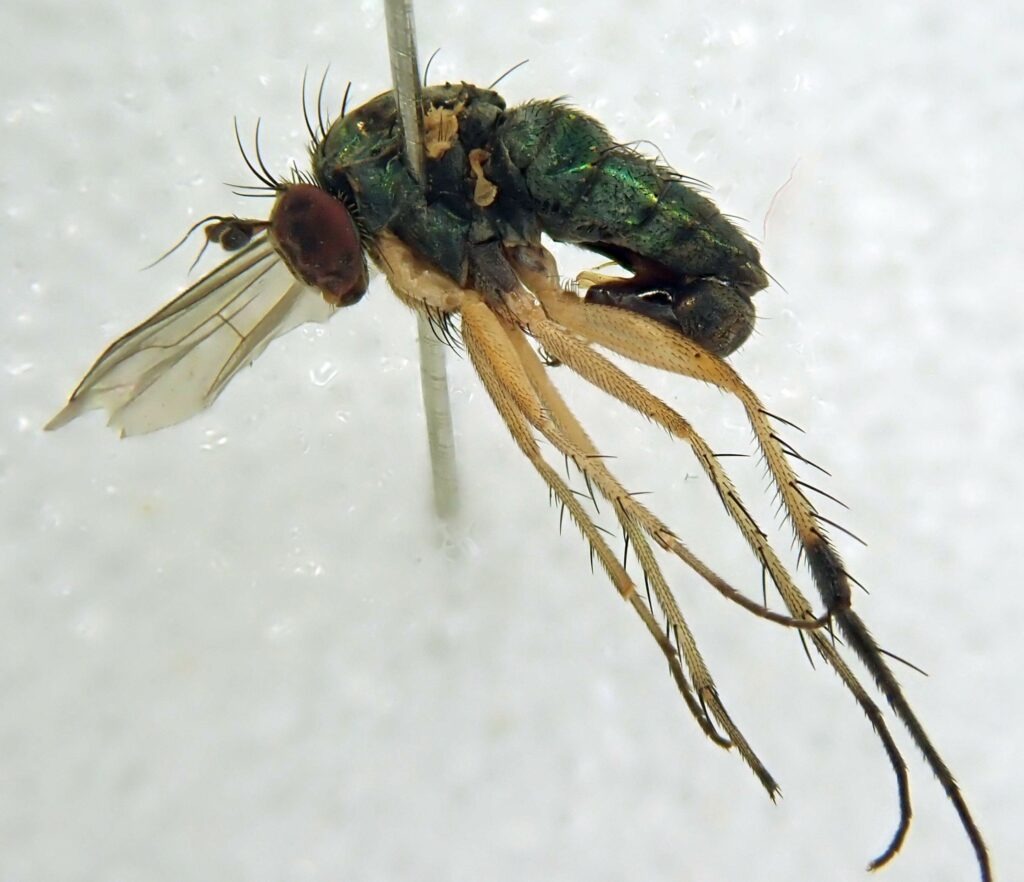
Lasiommata megera (Wall)
An orange-brown butterfly, widespread in England and Wales (and coastal in southern Scotland), but having experienced a major population decline in recent years. Now quite rare in most inland areas but still more regular along the coast, and indeed it was well represented at Deepdale, being noted in six of the eight compartments. The caterpillars feed on a range of grasses. Its status has been assessed as Endangered by Fox et al. (2022). Additionally, in England this butterfly is listed as a Special of Principal Importance in Section 41 of the Natural Environment and Rural Communities Act 2006.
Satyrium w-album (White-letter Hairstreak)
A small dark butterfly with distinctive white and orange markings on the underwings. Widespread but local in England and Wales in scrubby habitats. The caterpillars feed on elms Ulmus, and hence the species was severely affected by Dutch Elm Disease in the 1970s. A surprise sighting at Deepdale was of one alighting on a hedge. One would assume the butterfly is breeding on elms somewhere in the nearby woodland. Nationally, the status has been assessed as Vulnerable by Fox et al. (2022). Additionally, in England this butterfly is listed as a Special of Principal Importance.
Dolichopus agilis
One of the shiny green dolichopodid flies, very locally recorded from scattered sites in England and Wales, although from a wide range of habitats. A male was a good find. Its status has been assessed by Drake (2018) as Vulnerable to extinction in Britain, and Nationally Rare, meaning it is thought to occur in 15 or fewer 10-km squares in Britain.
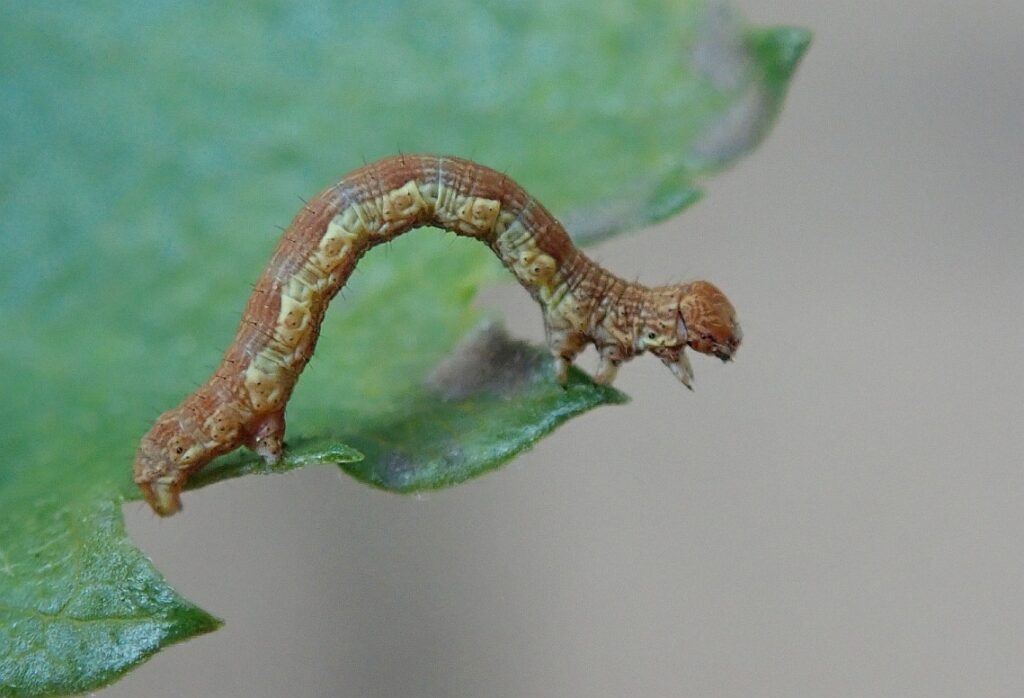
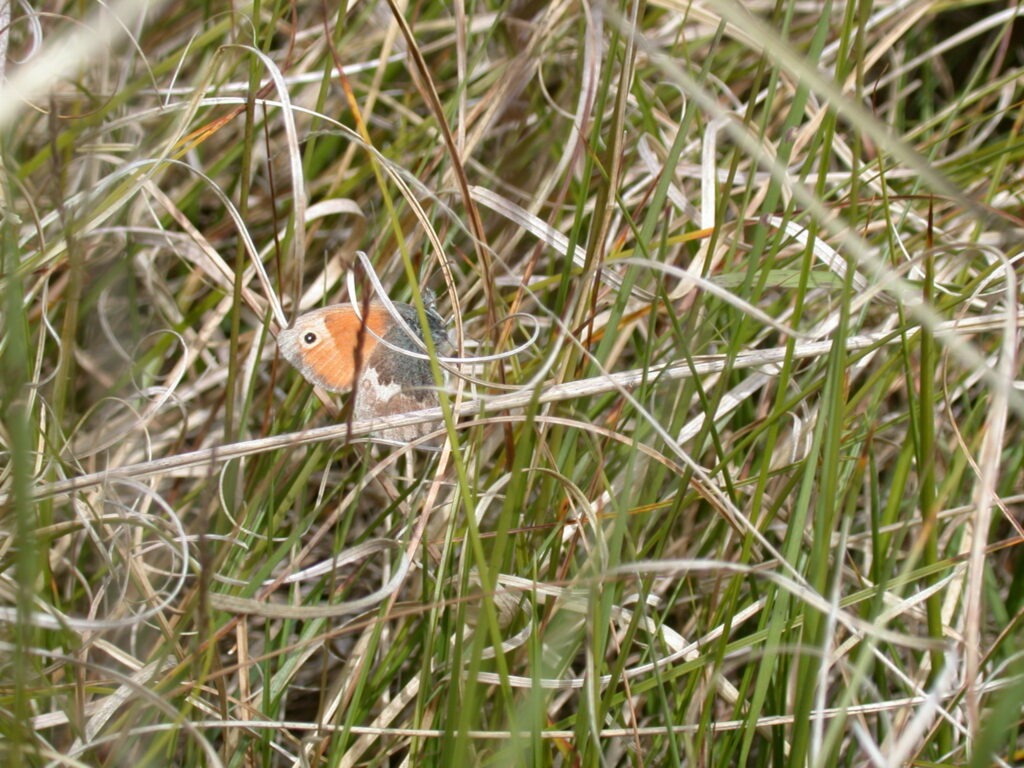
Erannis defoliaria (Mottled Umber)
A brownish (though variable) moth, flying late in the autumn, widespread in woodland and scrub across most of Britain. The caterpillars feed on a variety of trees and shrubs. One was beaten from the hedge along the edge of compartment E in May. Still a common species in many areas but given a provisional status of Vulnerable on the basis of significant declines in abundance in many areas.
Coenonympha pamphilus (Small Heath)
A small brown butterfly, favouring grassy habitats with a short sward. Distributed across almost all of Britain, but with a significant decline noted in many areas in recent years. Single butterflies were noted in August. Its status has been assessed as Vulnerable by Fox et al. (2022). Additionally, in England this butterfly is listed as a Special of Principal Importance.
Andy concludes
Invertebrate surveys at Deepdale in 2022 revealed a rich aspect to the farm’s biodiversity that would likely otherwise have gone largely unnoticed. In-depth studies of this sort emphasise that many species can thrive in a modern farmed landscape, including some considered rare or threatened. This is especially the case where attention is paid to enhancement of the environment, as at Deepdale.
A baseline to guide our farming practices
As the report makes clear, however, there can be very many species of insects present in quite a small area. Indeed, there will be many more that went undetected by the surveys. Developing conservation plans for every species individually is clearly impractical and there is sense in trying to create a generally biodiversity-sympathetic environment alongside our needs as humans to produce food and other ecosystem services from the land.
Organic farming is one of a range of such approaches, and it is interesting and valid to investigate the effects on biodiversity from going organic. Given that Deepdale Farm is in the early stages of making this transition to organic from the more conventional approach, this was an excellent time to undertake this baseline study of the invertebrates on the farm. It is hoped that the information and insights provided by this report are valuable in guiding some of the development of Deepdale in the coming years.
Repeating the survey
One of the stated aims of this Farming in Protected Landscapes project was “to repeat surveys in 2025 to allow for a comparison, in the final year of our five-year mid-tier Countryside Stewardship agreement.” This would seem a good opportunity to assess any impacts of the change in overall farm management approach on invertebrate biodiversity.
Sharing the methodology
Additionally, one other stated aims of the projects was that “results, methodology and any other learning will be shared with peers, NNNS, other interested parties and the press”. It is hoped that dissemination of this report can form a core part of achieving this aim. The author would be very happy to discuss the project and its findings with anyone interested in farmland invertebrate biodiversity. It would be particularly interesting to survey other farms (nearby or further afield) in a consistent manner. A larger dataset can only bring benefits in terms of understanding.
Find out more about FIPL funding
